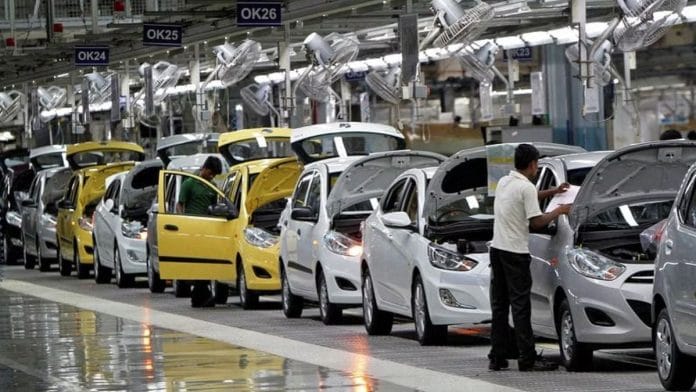New Delhi: The record inventory of cars and SUVs worth Rs 73,000 crore piling up at dealerships is due to “over ambitious” manufacturers and not a slowdown in customer demand, according to the Federation of Automobile Dealers Associations (FADA).
The FADA, which represents over 15,000 automobile dealerships, said the inventory levels have surged to a high of 67 to 72 days, as opposed to the desired level of 30-day paid-up stock. However, this is more to do with an oversupply than a fall in demand, it said.
“There is no slowdown in demand. The demand is very good,” FADA president Manish Raj Singhania told ThePrint. “In spite of creating such a humongous high last financial year (of PV sales), we see passenger vehicle sales grow every month. It is just that OEMs (original equipment manufacturers) are being over ambitious. Everybody wants to grab additional market share.”
He stressed this posed a substantial risk to a dealer’s sustainability, adding that dealers would not have complained had this level of stock been built up ahead of the festive season. But the stock has been pushed during the traditionally-lean sales months of July and August.
Asked about the possibility of more inventory being pushed ahead of the upcoming festive season, he said the dealerships in India “are now on the brink”. “Dealers cannot absorb more inventory… if sales are happening, why will dealers mind getting extra stock? The more we sell, the more profit there is for us.”
“OEMs should align their production and wholesales with retail sales,” Singhania added. “They cannot go overboard. On one hand, OEMs keep dumping vehicles for which there is stock already available, and on the other hand, few model variants will have a high waiting period.”
This imbalance, he said, raised the question of how manufacturers were assessing their supply chain. “They need to recalibrate and be more flexible on how to produce more vehicles which have high waiting periods.”
FADA has also written to the Society of Indian Automobile Manufacturers (SIAM), twice in two months, protesting the alleged dumping of stock on dealers.
In the second letter, seen by The Print, written 13 August, FADA highlighted a sharp increase in stock levels from approximately 6 lakh units in June to about 7.3 lakh units in July.
It also sought immediate stop to the practice of pushing inventory by OEMs against the will of the dealers, adding that financial health of the dealers was at stake. Replying to the first letter by FADA, SIAM had stated that it will take up the issue at its executive council meeting. However, it asked that the dealers take up the matter with their respective OEM partners.
The Print reached SIAM for a statement, and this report will be updated as and when a response is received.
Singhania added that while some OEMs were very good at planning supplies and had good business management systems in place, some just worked on a hunch.
He said given various variants of a model, fuel, transmission and colour options, finalising the supply chain dynamics involved a lot of permutation and combination.
Regarding questions raised about FADA’s own stock level metrics, Singhania explained that FADA takes the wholesales figures from SIAM, and retails sales figures from the Vahan portal.
“In Vahan portal, figures for Telangana are missing, but we have the retail figures. The state accounts for about 4.25% total India retail, so (if) we incorporate that we get all India retail figures. Wholesales minus all India retails is how we get our figure of tentative paid up stock. It is a simple calculation,” Singhania said.
He also added that OEMs usually have the upper hand, and dealers were not in a position to refuse stock.
“We can’t refuse. We work on monthly targets and are okay with stress-selling etc. What OEMs need to do is not be over ambitious. The growth should be aligned to the reality of the market. For example, X manufacturer is getting 5% year-on-year growth, but is aspiring for 30% growth and is producing as per that and dumping vehicles on dealerships,” Singhania added.
(Edited by Tikli Basu)






